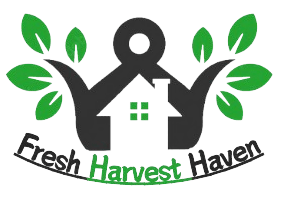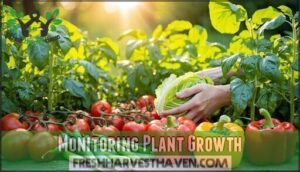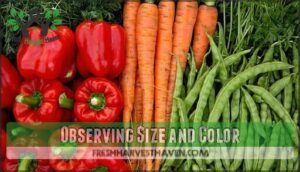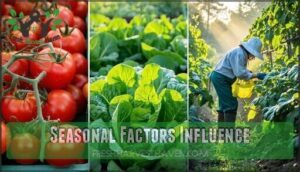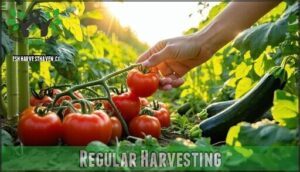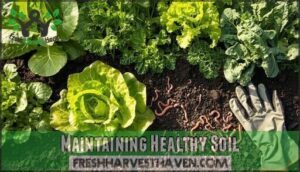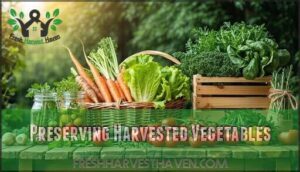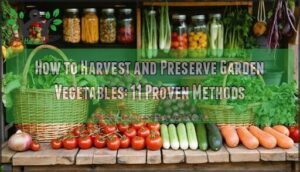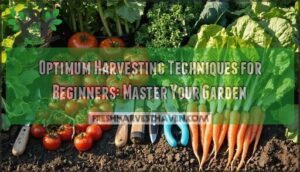This site is supported by our readers. We may earn a commission, at no cost to you, if you purchase through links.
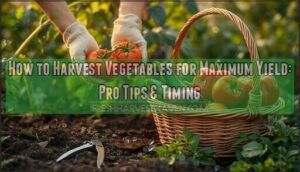
Pick in the morning when plants are fully hydrated and sugar content peaks. Use clean, sharp tools to prevent disease and damage.
Harvest at peak ripeness—look for color changes and proper firmness. Handle gently to preserve cell integrity and extend shelf life.
Regular picking signals plants to keep producing, boosting overall yield. Don’t let vegetables overripen on the plant, as this reduces quality and stops new growth.
The secret lies in understanding each crop’s unique signals and creating the perfect harvesting rhythm to ensure you’re picking at the right time for maximum quality and to maintain continuous production.
Table Of Contents
- Key Takeaways
- Harvesting Techniques Matter
- Harvesting Vegetables for Yield
- Choosing Right Harvest Time
- Maximizing Vegetable Yield
- Preserving Harvested Vegetables
- Frequently Asked Questions (FAQs)
- How often do you harvest vegetables?
- When should vegetables be harvested?
- How do you harvest vegetables?
- Which vegetables are high yield?
- What are the basics of harvesting?
- How do you know if a vegetable is ready for harvest?
- How to increase vegetable yield?
- How to maximize harvest?
- What is the highest yielding vegetable?
- What does 75 days to harvest mean?
- Conclusion
Key Takeaways
- Harvest in the morning when plants are fully hydrated and sugar content peaks – you’ll get better quality produce and extend shelf life
- Use clean, sharp tools and handle vegetables gently to prevent disease transmission and bruising that reduces quality and storage life
- Pick regularly at peak ripeness to signal plants to keep producing – don’t let vegetables overripen on the plant as this stops new growth
- Practice succession planting every 2-3 weeks and maintain healthy soil through amendments to boost yields up to 45% compared to single harvests
Harvesting Techniques Matter
The way you harvest your vegetables directly impacts both the quality of your produce and your garden’s ongoing productivity.
Proper harvesting techniques guarantee you get the most from each plant while keeping them healthy for continued production throughout the growing season, which is crucial for ongoing productivity and to ensure you get the most from each plant.
Handling Vegetables Gently
Treating vegetables like fragile treasures during harvest transforms ordinary crops into premium produce.
Your gentle touch determines whether you’ll enjoy perfect specimens or deal with bruised disappointments.
Avoid bruising through proper grasping techniques that protect cell integrity:
- Cup tomatoes in your palm to minimize pressure and prevent fingertip damage
- Support weight from underneath when detaching melons, never grab from above
- Cradle leafy greens with both hands to maintain structural integrity
- Hold peppers with your whole hand, avoiding the death grip that crushes delicate skin
These gentle handling methods are essential vegetable harvesting techniques that directly impact your ability to maximize vegetable yield while preserving flavor and extending shelf life.
Morning harvests help capture peak sugar content.
Using Clean and Sharp Tools
With clean tools, you’re cutting disease transmission at the source while protecting your investment.
Dull blades crush plant tissues, creating entry points for pathogens that minimize damage would otherwise avoid.
Tool sterilization between plants using rubbing alcohol prevents spreading issues throughout your garden.
Sharp harvesting tools make precise cuts that heal faster, helping plants extend lifespan and continue producing.
Tool maintenance isn’t just about efficiency—it’s about prevent bruising delicate produce and ensuring your harvesting techniques actually maximize vegetable yield.
Consider browsing options for specialized garden products to maintain your tools.
Clean cuts mean healthier plants and better harvests.
Harvesting at Optimal Time
Beyond sharp tools lies the art of perfect timing. Key harvest time separates novice gardeners from yield masters who understand that peak ripeness waits for no one.
Morning harvest delivers your best results. Plants are fully hydrated, and you’ll avoid the stress of midday heat that can compromise quality. Weather impact plays a vital role—dry conditions prevent disease while wet harvesting invites trouble.
Master these harvesting signals to nail your harvest timing:
- Monitor visual cues daily for color changes and firmness
- Check size against variety expectations for maturity
- Watch weather forecasts for ideal harvest window conditions
- Use taste testing when ripening signs indicate readiness
Your vegetables won’t wait around forever. Those visual cues—vibrant colors, proper texture, and ideal size—signal when nature’s ready to reward your patience with maximum flavor and nutrition.
Harvesting Vegetables for Yield
The key to harvesting vegetables for maximum yield lies in understanding that your garden operates like a well-oiled production line. When you harvest regularly, you’re basically telling your plants to keep producing.
High-yield varieties like indeterminate tomatoes and pole beans are your best investment. These powerhouses keep producing until frost hits. Pair them with vertical growing techniques to maximize space—think trellises for cucumbers and towers for beans.
Staggered sowing every two to three weeks guarantees continuous harvests rather than feast-or-famine cycles. Plant lettuce weekly, and you’ll never run out of fresh greens.
Microclimate control through strategic shade cloth or row covers can extend your harvest window by protecting sensitive crops during temperature swings.
Use targeted strategies for each crop—harvest beans when pods are pencil-thick, pick zucchini daily when six to eight inches long. Clean, sharp tools prevent plant damage that reduces future production.
The secret? Don’t let vegetables overripen on the plant. Regular picking signals continued production, boosting your garden crop yield by up to 45% compared to single harvests. For beans, consider that harvest timing matters to encourage continuous production.
Choosing Right Harvest Time
You’ll get the best yields when you harvest vegetables at their peak ripeness, not too early or too late.
Timing depends on watching for specific visual cues like color changes, checking size against variety standards, and considering weather conditions that affect plant maturity.
Monitoring Plant Growth
Success in harvesting starts with understanding your plants’ growth stage progression. Peak flavor and nutrient density occur when vegetables reach physiological maturity, indicated by stunted leaf growth and consistent fruit development.
Watch your plants like a hawk to catch the perfect harvest window. Daily monitoring helps you spot disease prevention opportunities and pest detection early, before problems spiral out of control.
Your plants tell their story through visual cues:
- Lettuce leaves that stop expanding signal readiness before bolting ruins quality
- Sweet corn silks that turn brown indicate peak ripeness indicators
- Tomato stems that thicken show vegetable maturity approaching
- Bean pods that feel firm reveal ideal size and color timing
Regular inspection reveals environmental impact on plant growth, helping you adjust care strategies. Smart gardeners document growth milestones to predict future harvest timing accurately.
Observing Size and Color
Your eyes tell the story of vegetable maturity.
Color Maturity shows when red bell peppers contain 30% more beta-carotene than green ones.
Size Standards matter too—optimal carrots reach 3/4 inch diameter for peak sweetness.
Green beans hit their flavor peak at 4-5 inches long.
Visual Cues like uniform coloring and firm texture signal peak ripeness.
Variety Differences affect timing, so check Ripeness Indicators specific to each crop you’re harvesting vegetables.
Seasonal Factors Influence
Weather patterns control your harvest success more than you might think.
Temperature impact shapes ripening speed, while humidity effects determine disease risk.
Cool mornings preserve crispness in leafy greens, but afternoon heat wilts them fast.
Rainfall timing creates tricky decisions.
Wet conditions boost fungal problems, reducing shelf life by 25%.
Smart gardeners watch forecasts and harvest during dry spells.
Sunlight intensity accelerates ripening in crops like tomatoes, extending your harvest window by seven days when temperatures fluctuate.
Frost concerns keep you on your toes.
One cold snap destroys tender plants overnight, wiping out weeks of growth.
Track your local frost dates and protect vulnerable crops.
These seasonal factors shape your strategy:
- Monitor temperature swings to time harvests perfectly
- Watch rainfall patterns to avoid soggy, disease-prone produce
- Use frost dates to protect cold-sensitive vegetables
Understanding harvest season rhythms maximizes vegetable yield while working with nature’s schedule, not against it.
This approach helps you work with nature, ensuring a more successful harvest by considering temperature impact, humidity effects, and frost concerns.
By tracking these factors and adjusting your strategy, you can extend your harvest window and reduce the risk of fungal problems.
Effective planning and monitoring are key to a successful harvest.
Maximizing Vegetable Yield
You can increase your harvest yield by up to 45% with the right approach. Focus on succession planting, frequent picking, and keeping your soil healthy to maximize what each plant produces.
Succession Planting
Beyond simply planting once, staggered planting transforms your garden into a production powerhouse.
Plant new seeds every 2-3 weeks for continuous harvest that extends your season by 60%. This succession planting strategy delivers maximum yield while preventing waste from overwhelming harvests.
Consider using staggered planting methods for a more consistent supply.
| Crop | Planting Interval |
|---|---|
| Lettuce | Every 2 weeks |
| Bush Beans | Every 3 weeks |
| Radishes | Every 10 days |
| Spinach | Every 2 weeks |
| Carrots | Every 3 weeks |
Smart crop rotation between plantings maintains soil health and increased yield potential.
Regular Harvesting
After planning your succession plantings, you’ll need to stay on top of regular picking to keep your plants pumping out produce. Consistent harvesting signals your plants to keep producing instead of going to seed, which shuts down production completely.
Harvesting vegetables frequently maintains continuous production and prevents seeding. This approach also preserves flavor maintenance and supports overall plant health while helping you achieve maximum yield.
Your regular picking schedule should include:
- Daily bean and pea harvests – Pick when pods snap cleanly
- Zucchini collection every 2-3 days – Harvest at 6-8 inches for best taste
- Tomato picking at first blush – This timing will encourage growth
- Weekly leafy green cuts – Regular trimming keeps them producing fresh leaves
These harvesting techniques keep your garden working overtime for you.
Maintaining Healthy Soil
After months of diligent planting and tending, healthy soil becomes your secret weapon for maximizing vegetable harvests.
Strong soil health directly impacts your garden’s productivity, with organic-rich amendments boosting next-season yield potential by up to 40%.
Transform your garden’s foundation with these proven strategies:
- Soil Amendments: Mix compost, aged manure, or leaf mold into beds for nutrient enrichment
- Crop Rotation: Rotate plant families annually to maintain soil balance and prevent depletion
- Water Management: Keep soil consistently moist without waterlogging to support root development
- Soil Testing: Check pH and nutrient levels yearly for targeted improvements
These soil enrichment practices create favorable growing conditions while supporting microclimate control and vertical growing systems.
Consider using specialized soil products for superior results.
Regular soil testing guarantees your amendments work effectively, preserving soil health for sustained production across multiple growing seasons.
Preserving Harvested Vegetables
You’ll need proper storage techniques to keep your freshly harvested vegetables crisp and nutritious for weeks or even months.
The way you handle and store your produce immediately after harvest determines whether you’ll enjoy peak flavor or watch your hard work wilt away in days, which is why proper handling is crucial for maintaining the quality of your vegetables, and proper storage is essential to preserve them.
Proper Storage Methods
Your harvest’s potential doesn’t end at picking—storage methods determine whether you’ll enjoy fresh vegetables for days or weeks.
Optimal Temperature varies by crop: leafy greens thrive in cold refrigeration, while tomatoes prefer room temperature to avoid cold damage. Container Types matter too—perforated bags allow airflow for root vegetables, while airtight containers trap moisture for herbs.
Humidity Control prevents wilting in delicate greens and stops root vegetables from shriveling. Keep Ethylene Gas producers like apples separate from sensitive crops to extend Storage Duration.
Your refrigeration settings should match each vegetable’s needs, while freezing requires blanching first to preserve quality. Using a hygrometer aids monitoring of both temperature and humidity.
These vegetable storage tips transform your garden bounty into lasting nutrition.
Factors Affecting Shelf Life
Understanding what affects your vegetables’ shelf life gives you the power to maximize your harvest’s value.
Storage temperature controls everything—dropping it by 10°F doubles freshness duration.
Harvesting conditions matter too; morning picking when plants are fully hydrated extends shelf life substantially.
Bruising prevention during postharvest handling stops decay before it starts.
Here are three game-changing factors:
- Humidity control matching each vegetable’s specific needs prevents wilting
- Ethylene production from nearby fruits accelerates spoilage by 50%
- Initial harvest quality determines maximum storage potential
Master these vegetable storage tips and watch your hard work pay dividends.
Extending Vegetable Season
While proper storage keeps your harvest fresh longer, you can also stretch your growing season far beyond what nature typically allows.
Smart gardeners use simple techniques to keep vegetables producing through winter months. Cold frames act like mini-greenhouses, protecting tender greens and extending your harvest by 6-8 weeks. Row covers and hoop tunnels create protective microclimates that shield crops from temperature swings during fall gardening phases.
Here’s your season extension toolkit:
- Cold Frames: Shield lettuce and spinach from harsh weather
- Row Covers: Protect tender crops from unexpected frost
- Hoop Tunnels: Create warm microclimates for extended harvests
- Indoor Growing: Grow herbs and leafy greens year-round
- Succession Planting: Stagger plantings every 2-3 weeks for continuous harvest
Variety selection matters too. Choose cold-hardy vegetables that thrive in cooler weather. With these extending harvest season strategies, you’ll transform your garden into a four-season food factory that never stops producing fresh vegetables. Consider purchasing gardening cold frames for superior results.
Frequently Asked Questions (FAQs)
How often do you harvest vegetables?
Sarah’s zucchini plants exploded with fruit, but she waited too long between harvests and ended up with baseball bat-sized squash nobody wanted.
You’ll harvest different vegetables at varying frequencies.
Beans, zucchini, and cucumbers need daily picking during peak season, while tomatoes require harvesting every 2-3 days when ripe.
When should vegetables be harvested?
You’ll know it’s time when vegetables show their ripeness cues – tomatoes turn deep red, cucumbers develop glossy skin, and carrots reach proper diameter.
Harvest in cool morning hours for best quality.
How do you harvest vegetables?
Forget those gentle gardening guides that treat vegetables like fragile flowers. You’ll harvest like a pro using sharp, clean tools and firm grips on stems, not leaves.
Which vegetables are high yield?
You’ll maximize your harvest with pole beans, indeterminate tomatoes, zucchini, leafy greens, and cucumbers. These powerhouse crops keep producing when you harvest regularly, giving you serious bang for your buck.
What are the basics of harvesting?
Harvest vegetables when they’re at peak ripeness using sharp, clean tools. Pick in the morning when plants are hydrated, handle gently, and harvest frequently to encourage continued production.
How do you know if a vegetable is ready for harvest?
Ironically, plants practically scream when they’re ready—you just need to know their language.
Check color changes, firmness, and size against variety expectations.
Tomatoes blush red, cucumbers develop yellow stem ends, and peppers shift from green to their final hue when ripe.
How to increase vegetable yield?
Plant high-yield varieties like indeterminate tomatoes and pole beans.
Practice succession planting every 2-3 weeks. Harvest frequently to encourage continued production.
Use vertical growing and maintain healthy soil through proper amendments.
How to maximize harvest?
Like striking gold in the garden, timing’s everything. Harvest daily when crops reach peak ripeness, use sharp tools, handle gently, and pick frequently to keep plants producing continuously.
What is the highest yielding vegetable?
Indeterminate tomatoes top the charts, producing continuously throughout the season. You’ll get 10-15 pounds per plant with proper care, making them your garden’s MVP for consistent, heavy yields.
What does 75 days to harvest mean?
75 days to harvest" means you’ll pick that vegetable 75 days after planting the seeds or transplants. It’s your countdown timer from garden to table, helping you plan successive plantings perfectly.
Conclusion
Mastering how to harvest vegetables for maximum yield is like conducting an orchestra—timing and technique create perfect harmony.
You’ve learned that morning harvests capture peak hydration and sugar content.
Sharp, clean tools prevent disease while gentle handling preserves quality.
Regular picking encourages continuous production, preventing plants from shifting energy to seed development.
Monitor growth stages, observe color changes, and maintain healthy soil for sustained yields.
Success comes from understanding each crop’s unique signals and developing your harvesting rhythm.
- https://yardandgarden.extension.iastate.edu/how-to/vegetable-harvest-guide
- https://hgic.clemson.edu/factsheet/harvesting-vegetables/
- https://dianfarmer.com/how-to-harvest-and-store-vegetables/
- https://fryd.app/en/magazine/yield-calculator-for-vegetables-calculate-area-requirements-and-harvest-quantities
- https://ponicslife.com/when-to-transplant-and-harvest-vegetables-a-complete-list/
